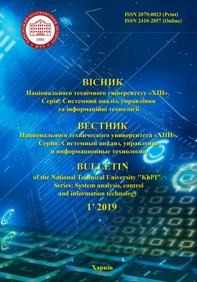RESEARCH OF METHODS OF DEVELOPMENT OF SOFTWARE COMPUTER ENGINEERING BASED ON TYPICAL SOFTWARE ELEMENTS
DOI:
https://doi.org/10.20998/2079-0023.2019.01.12Keywords:
software, computer engineering, information systems, components, typical design solutions, development costsAbstract
The paper deals with the problems of increasing the effectiveness of the development of IS, and, in particular, the issues of reducing the development time of the software package of IS. The analysis of technology development software in the life cycle of IS. A structural programming approach suggested decomposing programs in a step-by-step manner. The development of program structures is carried out using the construction of input and output data structures, identification of processing links between these data, formation of a program structure based on data structures and detected matches. It is possible to overcome the complexity factor if we deviate from a straightforward approach to solving the problem posed, consisting in sequential and linear extension of the source code of the program operator-by-operator, resulting in one long and amorphous program. Here, the modularity principle is effective: the initial problem is divided into relatively independent parts; they are implemented by separate software modules, which are then linked into a single unit at the layout stage. The features of the technology of automated program synthesis, namely, the technology of assembling programs from typical program elements, are highlighted. The basic concepts of the above technology have been identified, a study has been conducted to design programs from blocks and a problem area has been identified. The initial data for the formulation and solution of problems for the synthesis of a system of program modules are the set of information arrays of the system, for which there are defined: input, output and intermediate data; many alternative data processing procedures; sequence of procedures in the processing; ways of sharing with external memory. The approach to the selection of typical program elements that meet certain criteria is considered. On the basis of the considered approach, and also taking into account its shortcomings, an improved method was proposed for classifying typical program elements and a method for designing software based on them, taking into account minimizing the time and cost of the project.References
Strukturnoye programmirovaniye. [Structured programming] Available at: http://www.maksakov-sa.ru/TehProgram/StrProgr/index.html (accessed 16.12.2018).
Linger R., Mills H., Witt B. Teoriya i praktika strukturnogo programmirovaniya. [Theory and practice of structured programming] Available at: https://www.livelib.ru/book/1001405237/about-teoriya-i-praktika-strukturnogo-programmirovaniya-richard-linger (accessed 16.12.2018).
Sredstva strukturnogo proyektirovaniya. [Structural Design Tools] Available at: http://www.interface.ru/fset.asp?Url=/case/defs71.htm (accessed 04.02.2019).
Strukturnyye karty Dzheksona. [Jackson Structural Maps] Available at: http://mash-xxl.info/article/433911 (accessed 04.02.2019).
Proyektirovaniye programmnogo obespecheniya. Osnovy programmnoy inzhenerii. [Software design. Software Engineering Basics] Available at: http://swebok.sorlik.ru/2-software_engineering_designi (accessed 04.02.2019).
Sovremennyye metodologii strukturnogo analiza i proyektirovaniya. [Modern methodologies of structural analysis and design] Available at: http://swsys.ru/index.php? page=article&id=1025 (accessed 04.02.2019).
Proyektirovaniye programmnogo obespecheniya. [Software design] Available at: http://window.edu.ru/library/pdf2txt/965/28965 (accessed 04.02.2019).
Ob"yektno-oriyentirovannyy analiz i proyektirovaniye. [Object-oriented analysis and design] Available at: http://www.hardline.ru/1/5/1390/1789-6.htm (accessed 04.02.2019).
Booch G. Ob"yektno-oriyentirovannyy analiz i proyektirovaniye s primerami prilozheniy. [Object-oriented analysis and design with examples of applications] Available at: https://www.twirpx.com/file/279137 (accessed 04.02.2019).
Listrovoy S. V., Butenko V. M., Bryksin V. O., Golovko O. V. Development of method of definition maximum clique in a non-oriented graph. EasternEuropean Journal of Enterprise Technologies. 2017, vol. 5, no. 4 (89), pp. 12–17. EID: 2-s2.0-85032585697 DOI: 10.15587/1729-4061.2017.111056).
Listrovoy S. V., Panchenko S. V., Mojseenko V. I., Butenko V. M. Matematychne modelyuvannya v rozpodilenykh informatsiyno-keruyuchykh systemakh zaliznychnoho transportu [Mathematical modeling in distributed information-control systems of railway transport]. Kharkiv, 2017. 220 p.
Pavlenko E. P., Beruh I. C., Ayvazov V. A. Vybor tekhnologii razrabotki programmnogo obespecheniya informatsionnykh sistem [The choice of technology for developing software information systems]. ScienceRise [ScienceRise]. Kharkov, 2015, no. 5/2, pp.40–43
Listrovoy S. V., Golovko O. V., Butenko V. M., Ushakov M. V. Formulation of the Problem of Maximum Clique Determination in Non-Oriented Graphs. International Journal of Engineering & Technology. 2018, vol. 7, no. 4.3: Special Issue 3, pp. 293–297
Downloads
Published
How to Cite
Issue
Section
License
Copyright (c) 2019 Bulletin of the National Technical University "KhPI". Series: System analysis, control and information technologyAuthors who publish with this journal agree to the following terms:
- Authors retain copyright and grant the journal right of first publication with the work simultaneously licensed under a Creative Commons Attribution License that allows others to share the work with an acknowledgement of the work's authorship and initial publication in this journal.
- Authors are able to enter into separate, additional contractual arrangements for the non-exclusive distribution of the journal's published version of the work (e.g., post it to an institutional repository or publish it in a book), with an acknowledgement of its initial publication in this journal.
- Authors are permitted and encouraged to post their work online (e.g., in institutional repositories or on their website) prior to and during the submission process, as it can lead to productive exchanges, as well as earlier and greater citation of published work (See The Effect of Open Access).


